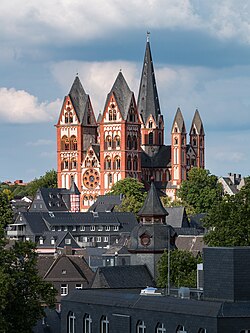Limburg Cathedral
| Limburg Cathedral | |
|---|---|
| The Cathedral of St George | |
| Limburger Dom | |

The cathedral towering the city
|
|
| 50°23′20″N 8°04′02″E / 50.3888°N 8.0671°ECoordinates: 50°23′20″N 8°04′02″E / 50.3888°N 8.0671°E | |
| Location | Limburg |
| Country | Germany |
| Denomination | Roman Catholic |
| History | |
| Founded | 1200 |
| Consecrated | 1235 |
| Architecture | |
| Status | Active |
| Functional status | Cathedral |
| Style | Romanesque |
| Specifications | |
| Bells | 9 |
| Administration | |
| Archdiocese | Archdiocese of Cologne |
| Diocese | Diocese of Limburg |
| Province | Province of Cologne |
The Catholic Cathedral of Limburg (German: Limburger Dom), also known as Georgsdom in German after its dedication to Saint George, is located above the old town of Limburg in Hesse, Germany. It is the cathedral of the Roman Catholic Diocese of Limburg. Its high location on a rock above the Lahn provides its visibility from far away. The building is one of the most perfect buildings of the late Romanesque style.
When the first church was built above the Lahn on the "Limburger Felsen" (German: "Limburg Rock") is not exactly known. According to a reference in the Nekrolog of the Basilica of St. Castor in Koblenz, Archbishop Hetti of Trier (814-847) consecrated a church of St George in "Lympurgensis."
Incidental archaeological discoveries from Carolingian times under the current church support the existence of a 9th-century church building in the area of the current chapel. There are no actual remains of the building however, nor any indications of its exact location or of its patron saint. Since the aforementioned record of its consecration was first written down in the sixteenth century, its accuracy has been controversial in scholarly literature.
On 10 February 910, King Louis the Child issued a deed for the foundation of a Stift of canons, which the Gaugraf of Niederlahngau, Konrad Kurzbold (~ 885–948) had pushed for. The construction of a Stift church probably began immediately. The choice of St George as patron is mentioned by Emperor Otto I in a document from the year 940. By then, the church had very likely already been completed.
...
Wikipedia
